#eastern imperial eagle
Text
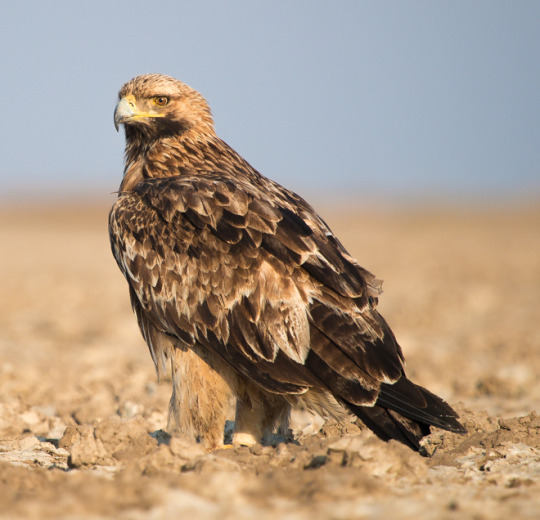
Posting birds until I hit post limit: Eastern imperial eagle
11 notes
·
View notes
Text

#philately#postage stamp#ephemera#vintage stamps#stamp collecting#hungary#hungary stamps#bird#eastern imperial eagle#eagle
0 notes
Note
Alamut!Nonnie here. I, for one, accept our feathered overlord. May he and his human reign long. Thank you for the lovely reply! It was... I have little words but I enjoyed it. A lot
Our Great Feathered Overlord Aquila is pleased with such displays of loyalty and has... uh...
"Human! I will agree to a 'fistbump' that Des has taught me! BE IN AWE!"

Yeah. That... apparently...
Anyway, I'm so glad you enjoyed my reply :)
#anonymous are called nonnies?#that's so adorable#i want more nonnies XD#i wanna be clear that the real aquila is a smaller eagle#like an eastern imperial eagle or a lesser spotted eagle#but that gif is just too fun not to use#ask and answer
7 notes
·
View notes
Text
no eagle can compare to the martial eagle in terms of name coolness, god damn
0 notes
Text
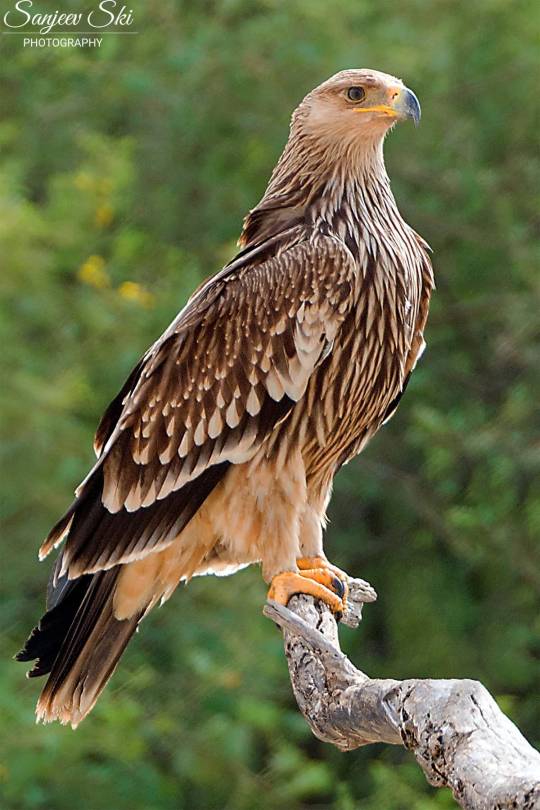
Sanjeev Ski
Eastern Imperial Eagle
Tal Chappar I Rajasthan T
DOP 26 Dec 2023
111 notes
·
View notes
Text
Fear and hunger termina bird assignments!
Starting off with Karin as a Pallas’ fishing eagle, they dominate other larger birds as competition and prey, plus I felt a raptor of some sort would be fitting for her

Daan as a grey catbird, I felt the generally unassuming aspect of them combined with the mimicking a cat’s call fit for him for Pocketcat reasons. Plus it’s just sort of his color

Abella as a Harris’ hawk, both because of their sort of general robustness plus they work together as pack hunters(the only bird of prey to do this!) and I thought that fit with her nature of sort of wanting to help out. Plus the ruddy shoulder feathers remind me of her hair

Levi as a pigeon, due to being kind of unassuming and because they’re seen as disposable, as well as their use in wartime to deliver messages, and how the species was sort of discarded in modern day

Marina as a killdeer, they’re not super sexually dimorphic for one and this is kind of just cause they’re a bird I’m fond of, their deception of pretending they’re injured to lure away predators and then flying away as well was something I considered

For Samarie, either a common loon or an anhinga, mostly going by vibes but the anhinga is also called a devil bird, and the expression of a loon being something to call someone crazy

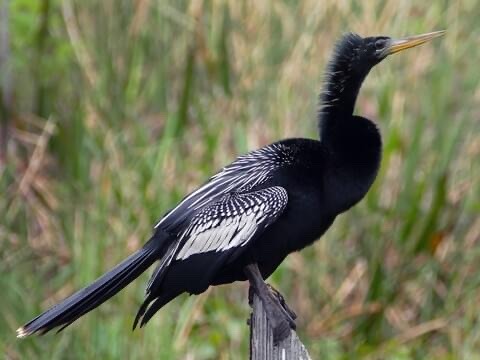
Cedar waxwing for Henryk, just kinda looks like him. Also he seems like he’d get drunk on fermented berries

Eastern imperial eagle for Pav, for the military significance of its title and then it also just looks like him

Sociable weaver for Olivia, their giant nests and the way they protect them for how family is involved in her story, as well as tying in her being a botanist by making her a weaver bird

35 notes
·
View notes
Text
Countries that are no more: Achaemenid Empire (550BC-330BC)
It was not the first empire of Iranian peoples, but it arose as probably the greatest in terms of influence and became the measure by which all subsequent Iranian empires tended to compare themselves and its influence on culture, government & civil infrastructure would influence others beyond the span of its territory and the span of time. This is the Achaemenid Empire.
Name: In Old Persian it was known as Xšāça or the "The Kingdom or the Empire", it was named the Achaemenid Empire by later historians. Named after the ruling dynasty established by its founder Cyrus the Great who cited the name of his ancestor Haxāmaniš or Achaemenes in Greek as progenitor of the dynasty. It is sometimes also referred to as the First Persian Empire. The Greeks simply referred to it as Persia, the name which stuck for the geographic area of the Iranian plateau well into the modern era.
Language: Old Persian & Aramaic were the official languages. With Old Persian being an Iranian language that was the dynastic language of the Achaemenid ruling dynasty and the language of the Persians, an Iranian people who settled in what is now the southwestern Iranian plateau or southwest Iran circa 1,000 BC. Aramaic was a Semitic language that was the common and administrative language of the prior Neo-Assyrian & Neo-Babylonian Empires which centered in Mesopotamia or modern Iraq, Syria & Anatolian Turkey. After the Persian conquest of Babylon, the use of Aramaic remained the common tongue within the Mesopotamian regions of the empire, eventually becoming a lingua franca across the land. As the empire spread over a vast area and became increasingly multiethnic & multicultural, it absorbed many other languages among its subject peoples. These included the Semitic languages Akkadian, Phoenician & Hebrew. The Iranian language of Median among other regional Iranian languages (Sogdian, Bactrian etc). Various Anatolian languages, Elamite, Thracian & Greek among others.
Territory: 5.5 million kilometers squared or 2.1 million square miles at its peak circa 500BC. The Achaemenid Empire spanned from southern Europe in the Balkans (Greece, Bulgaria, European Turkey) & northwest Africa (Egypt, Libya & Sudan) in the west to its eastern stretches in the Indus Valley (Pakistan) to parts of Central Asia in the northeast. It was centered firstly in the Iranian Plateau (Iran) but also held capitals in Mesopotamia (Iraq). Territory was also found in parts of the Arabian Peninsula & the Caucausus Mountains.
Symbols & Mottos: The Shahbaz or Derafsh Shahbaz was used as the standard of Cyrus the Great, founder of the empire. It depicts a bird of prey, typically believed to be a falcon or hawk (occasionally an eagle) sometimes rendered gold against a red backdrop and depicts the bird holding two orbs in its talons and adorned with an orb likewise above its head. The symbolism was meant to depict the bird guiding the Iranian peoples to conquest and to showcase aggression & strength coupled with dignity. The imperial family often kept falcons for the pastime of falconry.
Religion: The ancient Iranian religion of Zoroastrianism served as the official religion of the empire. It was adopted among the Persian elite & and had its unique beliefs but also helped introduce the concept of free-will among its believers, an idea to influence Judaism, Christianity & Islam in later centuries. Despite this official religion, there was a tolerance for local practices within the subject regions of the empire. The ancient Mesopotamian religion in Babylon & Assyria, Judaism, the Ancient Greek & Egyptian religions & Vedic Hinduism in India was likewise tolerated as well. The tolerance of the Achaemenids was considered a relative hallmark of their dynasty from the start. Famously, in the Old Testament of the Bible it was said that it was Cyrus the Great who freed the Jews from their Babylonian captivity and allowed them to return to their homeland of Judea in modern Israel.
Currency: Gold & silver or bimetallic use of coins became standard within the empire. The gold coins were later referred to as daric and silver as siglos. The main monetary production changes came during the rule of Darius I (522BC-486BC). Originally, they had followed the Lydian practice out of Anatolia of producing coins with gold, but the practice was simplified & refined under the Achaemenids.
Population: The estimates vary ranging from a low end of 17 million to 35 million people on the upper end circa 500BC. The official numbers are hard to determine with certainty but are generally accepted in the tens of millions with the aforementioned 17-35 million being the most reasonable range based on available sources.
Government: The government of the Achaemenid Empire was a hereditary monarchy ruled by a king or shah or later referred to as the ShahanShah or King of Kings, this is roughly equivalent to later use of the term Emperor. Achaemenid rulers due the unprecedented size of their empire held a host of titles which varied overtime but included: King of Kings, Great King, King of Persia, King of Babylon, Pharaoh of Egypt, King of the World, King of the Universe or King of Countries. Cyrus the Great founded the dynasty with his conquest first of the Median Empire and subsequently the Neo-Babylonians and Lydians. He established four different capitals from which to rule: Pasargadae as his first in Persia (southwest central Iran), Ecbatana taken from the Medians in western Iran's Zagros Mountains. The other two capitals being Susa in southwest Iran near and Babylon in modern Iraq which was taken from the Neo-Babylonians. Later Persepolis was made a ceremonial capital too. The ShahanShah or King of Kings was also coupled with the concept of divine rule or the divinity of kings, a concept that was to prove influential in other territories for centuries to come.
While ultimate authority resided with the King of Kings and their bureaucracy could be at times fairly centralized. There was an expansive regional bureaucracy that had a degree of autonomy under the satrapy system. The satraps were the regional governors in service to the King of Kings. The Median Empire had satraps before the Persians but used local kings they conquered as client kings. The Persians did not allow this because of the divine reverence for their ShahanShah. Cyrus the Great established governors as non-royal viceroys on his behalf, though in practice they could rule like kings in all but name for their respective regions. Their administration was over their respective region which varied overtime from 26 to 36 under Darius I. Satraps collected taxes, acted as head over local leaders and bureaucracy, served as supreme judge in their region to settle disputes and criminal cases. They also had to protect the road & postal system established by the King of Kings from bandits and rebels. A council of Persians were sent to assist the satrap with administration, but locals (non-Persian) could likewise be admitted these councils. To ensure loyalty to the ShahanShah, royal secretaries & emissaries were sent as well to support & report back the condition of each satrapy. The so called "eye of the king" made annual inspections of the satrapy to ensure its good condition met the King of Kings' expectations.
Generals in chief were originally made separate to the satrap to divide the civil and military spheres of government & were responsible for military recruitment but in time if central authority from the ShahanShah waned, these could be fused into one with the satrap and general in chiefs becoming hereditary positions.
To convey messages across the widespread road system built within the empire, including the impressive 2,700 km Royal Road which spanned from Susa in Iran to Sardis in Western Anatolia, the angarium (Greek word) were an institution of royal messengers mounted on horseback to ride to the reaches of the empire conveying postage. They were exclusively loyal to the King of Kings. It is said a message could be reached to anywhere within the empire within 15 days to the empire's vast system of relay stations, passing message from rider to rider along its main roads.
Military: The military of the Achaemenids consisted of mostly land based forces: infantry & cavalry but did also eventually include a navy.
Its most famous unit was the 10,000-man strong Immortals. The Immortals were used as elite heavy infantry were ornately dressed. They were said to be constantly as 10,000 men because for any man killed, he was immediately replaced. Armed with shields, scale armor and with a variety of weapons from short spears to swords, daggers, slings, bows & arrows.
The sparabara were the first line of infantry armed with shields and spears. These served as the backbone of the army. Forming shield walls to defend the Persian archers. They were said to ably handle most opponents and could stop enemy arrows though their shields were vulnerable to enemy spears.
There was also the takabara light infantry and though is little known of them it seems they served as garrison troops and skirmishers akin to the Greek peltast of the age.
The cavalry consisted of four distinct groups: chariot driven archers used to shoot down and break up enemy formations, ideally on flat grounds. There was also the traditional horse mounted cavalry and also camel mounted cavalry, both served the traditional cavalry functions and fielded a mix of armor and weapons. Finally, there was the use of war elephants which were brought in from India on the empire's eastern reaches. These provided archers and a massive way to physically & psychologically break opposing forces.
The navy was utilized upon the empire's reaching the Mediterranean and engaged in both battles at sea and for troop transport to areas where troops needing deploying overseas, namely in Greece.
The ethnic composition of Achaemenid military was quite varied ranging from a Persian core with other Iranian peoples such as the Medians, Sogdian, Bactrians and Scythians joining at various times. Others including Anatolians, Assyrians, Babylonians, Anatolians, Indians, Arabs, Jews, Phoenicians, Thracians, Egyptians, Ethiopians, Libyans & Greeks among others.
Their opponents ranged from the various peoples they conquered starting with the Persian conquest of the Medians to the Neo-Babylonians, Lydians, Thracians, Greeks, Egyptians, Arabs & Indians and various others. A hallmark of the empire was to allow the local traditions of subjugated areas to persist so long as garrisons were maintained, taxes were collected, local forces provided levies to the military in times of war, and they did not rebel against the central authority.
Economy: Because of the efficient and extensive road system within the vast empire, trade flourished in a way not yet seen in the varied regions it encompassed. Tax districts were established with the satrapies and could be collected with relative efficiency. Commodities such as gold & jewels from India to the grains of the Nile River valley in Egypt & the dyes of the Phoenicians passed throughout the realm's reaches. Tariffs on trade & agricultural produce provided revenue for the state.
Lifespan: The empire was founded by Cyrus the Great circa 550BC with his eventual conquest of the Median & Lydian Empires. He started out as Cyrus II, King of Persia a client kingdom of the Median Empire. His reign starting in 559BC. Having overthrown and overtaken the Medians, he turned his attention Lydia and the rest of Anatolia (Asia Minor). He later attacked the Eastern Iranian peoples in Bactria, Sogdia and others. He also crossed the Hindu Kush mountains and attacked the Indus Valley getting tribute from various cities.
Cyrus then turned his attention to the west by dealing with the Neo-Babylonian Empire. Following his victory in 539BC at the Battle of Opis, the Persians conquered the Babylonia with relative quickness.
By the time of Cyrus's death his empire had the largest recorded in world history up to that point spanning from Anatolia to the Indus.
Cyrus was succeeded by his sons Cambyses II and Bardiya. Bardiya was replaced by his distant cousin Darius I also known as Darius the Great, whose lineage would constitute a number of the subsequent King of Kings.
Darius faced many rebellions which he put down in succession. His reign is marked by changes to the currency and the largest territorial expansion of the empire. An empire at its absolute zenith. He conquered large swaths of Egypt, the Indus Valley, European Scythia, Thrace & Greece. He also had exploration of the Indian Ocean from the Indus River to Suez Egypt undertaken.
The Greek kingdom of Macedon in the north reaches of the Hellenic world voluntarily became a vassal of Persia in order to avoid destruction. This would prove to be a fateful first contact with this polity that would in time unite the Greek-speaking world in the conquest of the Achaemenid Empire. However, at the time of Darius I's the reign, there were no early indications of this course of events as Macedon was considered even by other Greek states a relative backwater.
Nevertheless, the Battle of Marathon in 490BC halted the conquest of mainland Greece for a decade and showed a check on Persia's power in ways not yet seen. It is also regarded as preserving Classical Greek civilization and is celebrated to this day as an important in the annals of Western civilization more broadly given Classical Greece & in particular Athens's influence on western culture and values.
Xerxes I, son of Darius I vowed to conquer Greece and lead a subsequent invasion in 480BC-479BC. Xerxes originally saw the submission of northern Greece including Macedon but was delayed by the Greeks at the Battle of Thermopylae, most famously by Spartan King Leonidas and his small troop (the famed 300). Though the Persians won the battle it was regarded as a costly victory and one that inspired the Greeks to further resistance. Though Athens was sacked & burnt by the Persians, the subsequent victories on sea & land at Salamis & Plataea drove the Persians back from control over Greece. Though war would rage on until 449BC with the expulsion of the Persians from Europe by the Greeks.
However, the Greeks found themselves in a civil war between Athens & Sparta and Persia having resented the Athenian led coalition against their rule which had expelled them from Europe sought to indirectly weaken the Greeks by supporting Greek factions opposed to Athens through political & financial support.
Following this reversal of fortune abroad, the Achaemenid Empire not able to regain its foothold in Europe, turned inward and focused more on its cultural development. Zoroastrianism became the de-facto official religion of the empire. Additionally, architectural achievements and improvements in its many capitals were undertaken which displayed the empire's wealth. Artaxerxes II who reigned from 405BC-358BC had the longest reign of any Achaemenid ruler and it was characterized by relative peace and stability, though he contended with a number of rebellions including the Great Satraps Revolt of 366BC-360BC which took place in Anatolia and Armenia. Though he was successful in putting down the revolt. He also found himself at war with the Spartans and began to sponsor the Athenians and others against them, showcasing the ever dynamic and changing Greco-Persian relations of the time.
Partially for safety reasons, Persepolis was once again made the capital under Artaxerxes II. He helped expand the city and create many of its monuments.
Artaxerxes III feared the satraps could no longer be trusted in western Asia and ordered their armies disbanded. He faced a campaign against them which suffered some initial defeats before overcoming these rebellions, some leaders of which sought asylum in the Kingom of Macedon under its ruler Philip II (father of Alexander the Great).
Meanwhile, Egypt had effectively become independent from central Achaemenid rule and Artaxerxes III reinvaded in around 340BC-339BC. He faced stiff resistance at times but overcame the Egyptians and the last native Egyptian Pharaoh Nectanebo II was driven from power. From that time on ancient Egypt would be ruled by foreigners who held the title Pharaoh.
Artaxerxes III also faced rebellion from the Phoenicians and originally was ejected from the area of modern coastal Lebanon, Syria & Israel but came back with a large army subsequently reconquered the area including burning the Phoenician city of Sidon down which killed thousands.
Following Artaxerxes III's death his son succeeded him but a case of political intrigue & dynastic murder followed. Eventually Darius III a distant relation within the dynasty took the throne in 336BC hoping to give his reign an element of stability.
Meanwhile in Greece, due to the military reforms and innovations of Philip II, King of Macedon, the Greek speaking world was now unified under Macedon's hegemony. With Philip II holding the title of Hegemon of the Hellenic League, a relatively unified coalition of Greek kingdoms and city-states under Macedon premiership that formed to eventually invade Persia. However, Philip was murdered before his planned invasion of Asia Minor (the Achaemenid's westernmost territory) could commence. His son Alexander III (Alexander the Great) took his father's reforms and consolidated his hold over Greece before crossing over to Anatolia himself.
Darius III had just finished reconquering some rebelling vestiges of Egypt when Alexander army crossed over into Asia Minor circa 334BC. Over the course of 10 years Alexander's major project unfolded, the Macedonian conquest of the Persian Empire. He famously defeated Persians at Granicus, Issus and Gaugamela. The latter two battles against Darius III in person. He took the King of Kings family hostage but treated them well while Darius evacuated to the far eastern reaches of his empire to evade capture. He was subsequently killed by one of his relatives & satraps Bessus, whom Alexander eventually had killed. Bessus had declared himself King of Kings though this wasn't widely recognized and most historians regard Darius III, the last legitimate ShahanShah of Achaemenids.
Alexander had taken Babylon, Susa & Persepolis by 330BC and effectively himself was now ruler of the Persian Empire or at least its western half. In addition to being King of Macedon & Hegemon of the Hellenic League, he gained the titles King of Persia, Pharaoh of Egypt & Lord of Asia. Alexander would in time eventually subdue the eastern portions of the Achaemenid realm including parts of the Indus Valley before turning back to Persia and Babylon where he subsequently became ill and died in June 323BC at age 32. Alexander's intentions it appears were never to replace the Achaemenid government & cultural structure, in fact he planned to maintain and hybridize it with his native Greek culture. He was in fact an admirer of Cyrus the Great (even restoring his tomb after looting) & adopted many Persian customs and dress. He even allowed the Persians to practice their religion and had Persian and Greeks start to serve together in his army. Following his death and with no established successor meant the empire he established which essentially was the whole Achaemenid Empire's territory in addition to the Hellenic world fragmented into different areas run by his most trusted generals who established their own dynasties. The Asian territories from Anatolia to the Indus (including Iran and Mesopotamia) gave way to the Hellenic ruled Seleucid Empire while Egypt became the Hellenic ruled Ptolemaic Kingdom. The synthesis of Persian and Greek cultures continued in the Seleucid and Greco-Bactrian kingdoms of antiquity.
The Achaemenid Empire lasted for a little over two centuries (550BC-330BC) but it casted a long shadow over history. Its influence on Iran alone has persisted into the modern age with every subsequent Persian Empire claiming to be its rightful successor from the Parthian & Sasanian Empires of pre-Islamic Iran to the Safavids of the 16th-18th century and the usage of the title Shah until the last Shah's ejection from power in the 1979 Islamic Revolution. Even the modern Islamic Republic of Iran uses Achaemenid imagery in some military regiments and plays up its importance in tourism and museums as a source of pride to Persian (Farsi) & indeed Iranian heritage. Likewise, its form of governance and the pushing of the concept of divine rights of kings would transplant from its Greek conquerors into the rest of Europe along with various other institutions such as its road & mail system, tax collection & flourishing trade. Its mix of centralized & decentralized governance. Its religious & cultural tolerance of local regions even after their conquest would likewise serve as a template for other empires throughout history too. The Achaemenid Empire served as a template for vast international & transcontinental empires that would follow in its wake & surpass its size & scope of influence. However, it is worth studying for in its time, it was unprecedented, and its innovations so admired by the likes of Alexander the Great and others echo into the modern era.
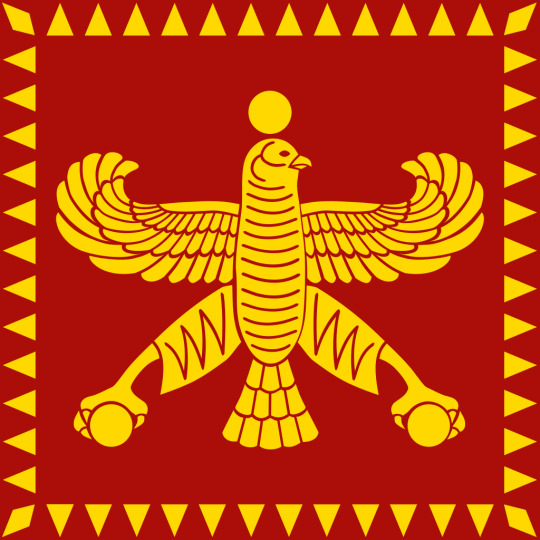
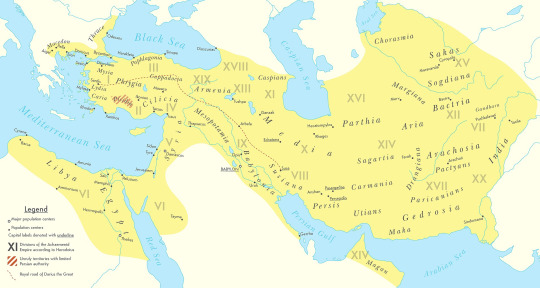


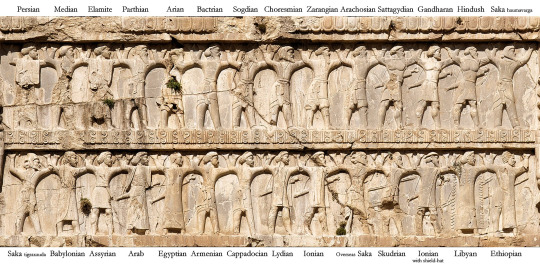
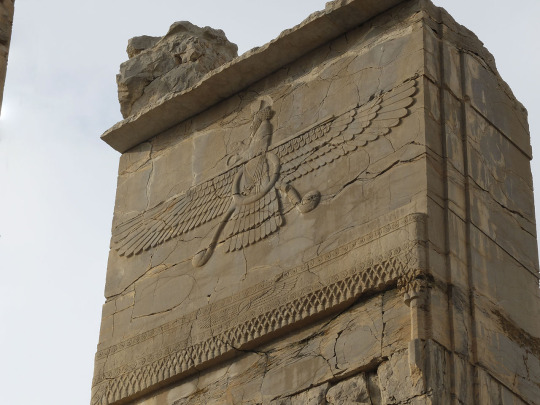




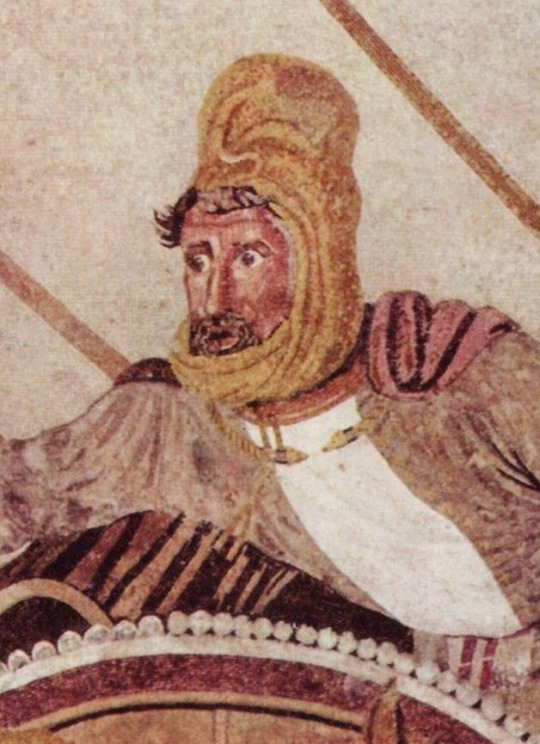
#military history#antiquity#iran#greece#ancient greece#classical greece#ancient ruins#ancient iran#ancient persia#achaemenid#persia#zoroastrianism#alexander the great#cyrus the great#xerxes#artwork#government#history#persian empire#ancient egypt
93 notes
·
View notes
Text
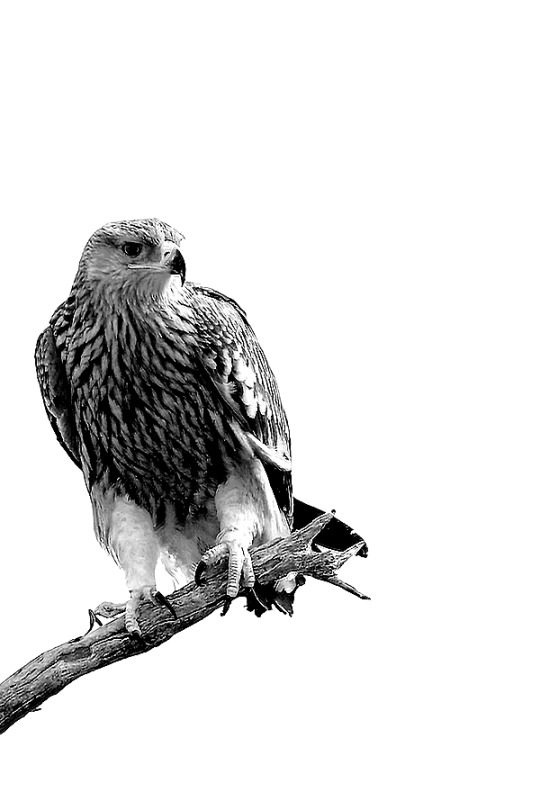
Eastern Imperial Eagle by Sanjeev Ski
28 notes
·
View notes
Text
Birds of Maglor’s Gap and Lothlann
This completes my series on birds of the Fëanorian realms pre Amon Ereb!!
March of Maedhros, Himlad, Thargelion, Estolad
Flora, Fauna, geography and environment of Arda Masterlist
Maglor’s Gap was the widest break in the mountains and cliffs dividing Beleriand and the lands to the north. It lay between the blue mountains to the east and the March of Maedhros to the west. Lothlann was a wide expanse of plains to the north of the Gap. The rivers greater and little Gelion ran around the western and eastern borders.
Steppes and plains: Daurian, see see partridge, yellowhammer, black grouse, grey necked bunting, great rosefinch, imperial Eagle, steppe eagle, golden eagle, Mongolian ground jay (rare), greater short toed lark, upland buzzard, Pallas’s sandgrouse, laughing dove, great bustard, bush quail, gray, black and painted francolin, snowcock, little bustard, merlin, cheer pheasant, crested lark, painted sandgrouse, scrubfowl, common quail, brown accentor, ring necked pheasant, grey partridge, black bellied sandgrouse, common buzzard, black kite
By greater and little Gelion (stream/river): black faced bunting, Pallas’s bunting, pin tailed sandgrouse (summer only), white throated dipper, brown dipper, common kingfisher, hobby, swamphen
World building notes
--Laughing doves appear on the sigil of some of Maglor’s host who are particularly skilled in the use of song in battle
-Many of Maglor’s cavalry hunt or fight with birds including golden, steppe and imperial eagles.
-Game birds of the prairie steppes such as partridge make up much of the meat that the cavalry and scouts eat, along with hares.
-Most of the cavalry have horse hair plumes but some of the lieutenants and generals have feathers from pheasants or eagles.
-Emu are actually domesticated in some parts of the world and I love the idea of them being kept in both the Gap and Himlad as well as by peoples East of the Ered Luin. They have a huge variety of uses including leather, oil, eggs and meat. And the chicks are very cute 💙
-I am a huge proponent of prehistoric and extinct animals living throughout Arda, as per Tolkien’s comments about “all creatures which walk or have walked the earth”. I really like the idea of small brush moas living near the mountain borders of the Gap
27 notes
·
View notes
Text
Today, I'm going to share some fascinating insights into one of the most iconic flags in the world – the Greek national flag. So grab an ouzo and let's dive into its colourful history.
You might know it as the "blue and white", but did you know the Greek flag is also referred to as the "Γαλανόλευκη" or "Galanolefki" in Greek? It means "blue and white".
The flag consists of nine horizontal stripes alternating between blue and white. The top and bottom stripes are blue, while the white cross on the upper left corner symbolises Eastern Orthodox Christianity, the established religion of the Greeks. Why nine, you ask? Well, it's believed to represent the nine syllables of the Greek phrase "Ελευθερία ή Θάνατος" ("Eleftheria i Thanatos"), which translates to "Freedom or Death" – the famous rallying cry of the Greek War of Independence (1821-1830) against the Ottoman Empire.
As for the colours, blue and white? The blue represents the sky and the sea – two elements deeply intertwined with Greece's identity. The white signifies the purity of the Greek struggle for freedom and independence. Quite poetic, isn't it?
Now, let's jump into a bit of history. Although the modern flag we know today was officially adopted on 22 December 1978, its roots can be traced back to the Byzantine Empire (330-1453 AD). The Byzantine flag featured the double-headed eagle and the imperial colours – yellow and purple. After the fall of the Byzantine Empire, these colours fell out of use, and blue and white emerged as symbols of the Greek nation.
During the Greek War of Independence, different variations of the flag were used by Greek forces. One of the most famous examples is the flag raised by Andreas Londos, a leader in the Greek Revolution, featuring a white cross on a blue background. Another flag, raised by Nikitaras, another revolutionary leader, had the blue cross on a white background.
#goexploregreece#goexplore#exploremore#exploregreece#exploretheworld#explore#tradition#world flags#greek flag#travel tips#traveling#traveller#travelling#travel#greecestagram#greecetravel#celebration#inspiration
13 notes
·
View notes
Text
TV Recommendation: The Long Ballad

In the early 600s C.E., the greatest threat to the Tang Dynasty is the Eastern Turkish Khaganate.
While the Khaganate’s elite Ashile Eagle Division is laying the groundwork for cooperation or failure within the capitol, the inferior of the empire’s two princes- Prince Qin- overthrows his brother the Crown Prince in a bloody coup that leaves the Crown Prince’s family annihilated.
All except for Prince Qin’s niece, who he’d always treated as a daughter.
Now a fugitive, Princess Chang Ge poses as a man and hides within the city- repeatedly running into a dashing young smuggler named A’Zun. A’Zun is clever, rich, and a peerless warrior- but he’s quickly enchanted by Chang Ge, even before realizing she’s a woman.
Chang Ge has sworn to overthrow her uncle and pay him back for betraying her family, no matter the cost. She steals the imperial seal of the office of the Crown Prince and flees the city with A’Zun’s help, then runs into him time and again on the road as they dodge dangers and traps.
But what Chang Ge does not realize is that A’Zun is no smuggler. He is Ashile Sun, the most elite commander and military strategist in the Khaganate.
And he is within Tang borders at the order of the Khan himself, tasked with bringing down the empire once and for all.
A brilliant strategist and warrior in her own right, Chang Ge seeks to dethrone the new Crown Prince and destroy his family as he destroyed hers (Except maybe not his daughter, her beloved cousin who wants nothing more than to protect Chang Ge).
What will a world-weary Chang Ge do once she figures out her dear new friend A’Zun is the legendary Ashile Sun?
And what kind of hell will be unleashed if Chang Ge and Ashile Sun work together?
#the long ballad#the descriptions for this show that I've seen all describe it starting halfway through
53 notes
·
View notes
Text
Babylon -> Rome -> United States
I like how historians arbitrarily categorize historical events by stating that they started here and ended there. Like the process of time and humanity can be divided into well-defined boxes. History bleeds into the future rather than shifts.
The Roman Empire is alive and well, Eastern and Western Europe still divided. The Empire itself was a millennia long process that didn't start or end with any single event. Western Europe, namely Spain, France, and England are all continuations of Rome, and the invasion/settlement of the Americas was a furthering of Roman expansionism in terms of cultural influence. They brought what was initially Mycenean staples like money, architecture, laws, writing, language etc to Europe, which itself was an extension of Canaanite, Egyptian, and Mesopotamian cultural expansion and influence. Imperialism itself should've died with the Empire, but instead persisted in the Empire's remains. Like how a child might continue their parents' toxic behavior. The Bald Eagle is /still/ the Eagle of Rome.
Also, on another note, the Cold War is alive and well, and not-so cold. The US and Russia can state internationally about armistices and the dismanteling of bombs all they like, but we all know better than that. The moment one side surrenders a piece, the game is over. It's just a game of who'll get caught first. The Cold War continued into proxy wars over dominance in the Middle East, a priceless piece in a world still dependent on fossil fuels for war. The same area was disputed in both World Wars for the /same reason./ I'd argue that the Cold War was the start of World War 3, a Silent War. Russia wants an Eastern Roman Empire while the US wishes for a Western.
Cyber and spy warfare has been at its height over the last several decades, whether the public is aware of it or not. This war is not Cold, it's Silent. Warfare has become ever more precise and quiet. But this is again the inevitable continuation and unfoldment of what Rome was a thousand years ago.
These events never ended, and we're alive today to witness the process rather than events like yesterday, today, and tomorrow.
4 notes
·
View notes
Note
This is super out there, but… continuing with the ATG in modern times theme lol, what do you imagine he’d think of aerial warfare?? :o OR on the flip side, if aerial warfare somehow became a possibility in his time period (like some sort of ancient steampunk verse)? In my mind, if he were transported here, he’d be super fascinated and come up with some potentially really ingenious uses for it… and also jealous he never got to try it out 😅
As part of the Pseudo-Callisthenes Alexander Romance, we have this wonderful tale of Alexander being carried aloft by eagles (or griffins, it varies). He climbs into a big basket which is attached to a yoke-thing tied to eagles/griffins. Then he sticks a piece of meat on the end of a sarissa and holds it out. The eagles/griffins want the meat…and carry him up trying to get it.
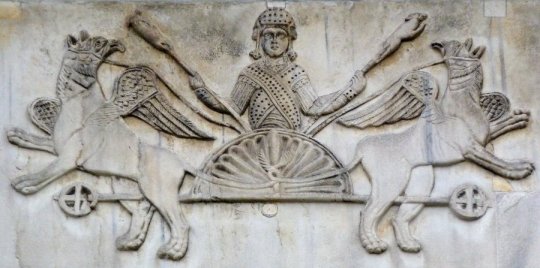
I love this story. It may date as early as the late Hellenistic/early imperial period. Similar versions show up in other ancient near eastern texts, with other popular heroes. (There’s also a story of him going down into the sea in a glass barrel.)

Anyway, I’m sure Alexander would LOVE airplanes (or zeppelins), for warfare, sure, but just in general. At heart, he’s an explorer as much as a conqueror. He has deep curiosity. So the chance to go UP and see the world from the angle of birds? He’d be all over that!
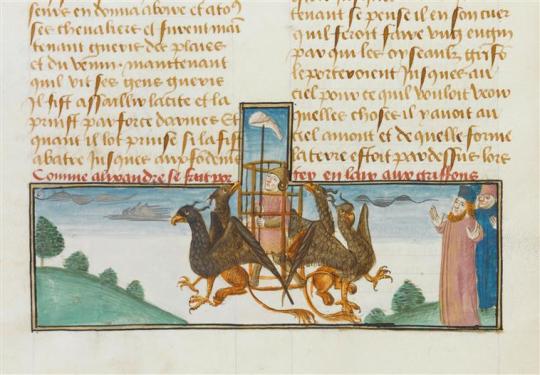
I don’t think he’d have much trouble shifting from 2D (land) warfare to 3D, as you’d need with aerial fights. He had a very flexible mind that wasn’t bound by the box others around him saw. We did see him utilize “height” in sieges, such as that against Gaza, raising ramparts for siege engines, bringing them up to the same level as the (elevated) city. He also sent soldiers up the back of the Sogdian Rock (in the dark) in order to put soldiers ABOVE the Sogdians hiding in the mountain caves.
So if he can use elevation as a tactic in land battles, imagine what he could do with airplanes?

#asks#Alexander the Great#Alexander Romance#Alexander the Great and flight#Alexander would have LOVED airplanes#Classics#ancient history#tagamemnon
9 notes
·
View notes
Text

Manju Nath
Eastern Imperial Eagle, LRK, Gujarat, India,
November 22
56 notes
·
View notes
Note
https://greekreporter.com/2022/09/22/byzantine-history-putin-russian-empire/
Καλημέρα θείτσα!
Sooooo i just saw this and wanted to ask your opinion on it ?
Hmmm I don't think the article gives me enough information to agree or disagree with it. The writer didn't mention the ways Putin attempts to do that reclamation besides the two-headed eagle - which is a very old symbol many countries on this side of the world use. Besides, the double-headed eagle has been used long before Putin.

The symbols the writer mentioned are more connected to Orthodoxy, which was heavily connected to the Eastern Roman Empire (Byzantium). The clothing, the symbols, the church architecture, all were cultural parts imported from Byzantium centuries ago and integrated into Russian culture(s).
The fact that Putin uses traditional or/and imperial imagery to sway the masses is a problem (I mean, Putin himself is a problem) but one can't exactly say that Russians remembered Rome and Orthodoxy now.
3 notes
·
View notes
Text
Symbolism in Kingdom's music videos. Issue #5
This time we will talk about the symbol of Chiwoo - the dragon.
DRAGON (Greek drakon) — "winged serpent", but only with paws like an eagle, combines a snake and a bird, spirit and matter, sometimes fire-breathing.
Initially, the symbolism of the dragon was entirely favorable and meant the waters bearing life (snake) and the breath of the earth (bird). He identified with the heavenly gods and their earthly representatives — emperors and kings. Subsequently, its symbolism became ambivalent, denoting the blessed rains following thunderstorms, and, at the same time, the destructive forces of lightning and floods.
The dragon can be solar and lunar, male and female, good and evil.
The dragon and the serpent are usually interchangeable in symbolism, representing the implicit, the indistinguishable, chaos, latent, unbridled nature, as well as the life-giving power of water. When he spews thunder and lightning, there is a transition from the unmanifested world to the created world of form and matter. And here the dragon has a dual symbolism: he can act both as the rain god and as his opponent, who does not let the rain fall. It is associated, on the one hand, with the sea and the depths of the sea, on the other — with the peaks of mountains, clouds and solar eastern regions.
Acting as monsters, dragons are the "lords of the earth", with whom heroes, conquerors and creators have to fight in order to capture or liberate the earth. They are also the keepers of treasures and access to secret knowledge. The dragon is also a symbol of longevity.
In the East, the dragon is usually a Heavenly Force that brings good, whereas in the West it is considered as a destructive and evil force.
In the Far East, it symbolizes cosmic and supernatural power, wisdom, hidden knowledge, the power of the waters that carry life. Dragons guard treasures, they serve as symbols of fertility and strength. This is the emblem of the Emperor as the Son of Heaven and a wise and noble man. The humming of the dragon testifies to the fullness of vitality (qi) and generative power (jing).
In Christian culture, the dragon is a mythical monster with foul breath and scaly body, lion claws, bat—like wings, and forked tongue and tail; the dragon is a symbol of death, darkness and the devil as a serpent who led a person into sin.
A dragon on a chain means defeated evil, often his tail is tied in a knot, since there is a belief that a dragon, like a scorpion, has power in the tail.
Despite this characteristic, kings and emperors chose the dragon as their symbol (Dann is no exception). The ancient Britons made the dragon their symbol of the struggle against the Saxon invaders.
Among the Celts, the dragon symbolizes the ability to inspire terror, as well as invincibility, and hence independence.
The battle with the dragon symbolizes the difficulties that must be overcome in order to master the treasures of inner knowledge. The victory over the dragon represents the resolution of the conflict between light and darkness, the destruction of destructive forces of evil or the victory over man's own dark nature and the achievement of self-control.
In China, this being with the greatest spiritual power is a symbol of life and light; the emblem of the Chinese imperial family is a golden dragon. According to the eastern horoscope, the dragon is the happiest sign.
As a sacred celestial Dragon, the patron saint of the Chinese people, the red star Antares (alpha of the constellation Scorpio) is revered in the Celestial Empire.
The hieroglyph of the dragon — Ryu — means mind, strength, energy of ability, whole nature. This sign can also be used as a dragon's own name.
In Russia, the dragon was completely identified with the serpent — the sign of Satan, the devil. It was considered an emblem of the forces opposing Holy Russia. The images of fabulous monsters in the works of Russian folklore (Serpent Gorynych) have a well-known similarity with the dragon.
In alchemical symbolism, the dragon represented the nature of Mercury.

4 notes
·
View notes